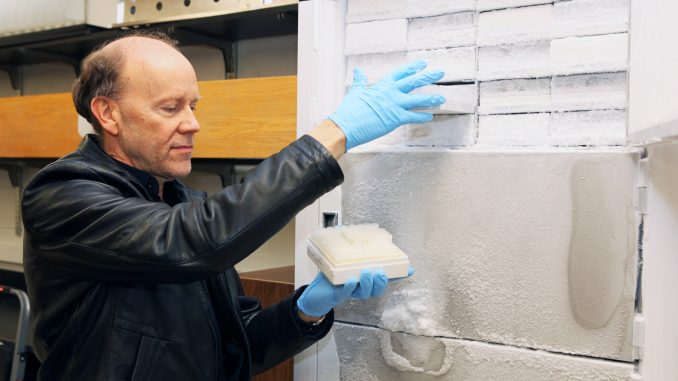
Four years ago, Dr. S. Blair Hedges and his team of researchers set out for the mountainous Haitian forests by helicopter. They were dropped off at the top of the mountain. The helicopter would not return for 24 hours.
Hedges, a biology professor for the Carnell graduate program and director of the university’s Center for Biodiversity, has been studying amphibians in the Caribbean for more than 30 years, but has forged a new path with his most recent project.
“I first went to Haiti in the 1980s as a student,” he said. “Haiti is of interest because it is one of the first places where the most biodiversity could disappear if things continue like deforestation.”
As an evolutionary biologist, Hedges said he has never had a focus on preservation of species until now. He said he started gathering different amphibians and sequencing their DNA to see how they are related, but quickly realized another use for their genetic material.
He decided to begin freezing the specimens with the potential for whole organism cloning through cryogenics, the process of storing specimens at very low temperatures for preservation.
“The idea is to freeze genetic material so that organisms can be brought back to life in the future,” Hedges said. “Much like Jurassic Park.”
In the process of collecting these animals, Hedges said he discovered many species thought to be extinct for some time and some that had yet to be discovered.
“Honestly, we found more new species than I anticipated; it’s been a huge number,” he said. “A lot of them haven’t been named yet, like a little frog that lays green eggs, like Dr. Seuss’ ‘Green Eggs and Ham.’ I’m thinking about dedicating the frog to Dr. Seuss. No other frog I know of in the world has these green eggs.”
Though Hedges has done research in the Caribbean for decades, this particular project began at a time of distress in Haiti, as the country was just starting to recover from the 7.0 magnitude earthquake it experienced in 2010.
Sarah Hanson, a research assistant for the project, said that on her first trip in 2012, debris remained scattered in the hard hit capital of Port-au-Prince.
“It was a bit overwhelming,” the 2013 Penn State graduate said. “On the first day, everyone went into the field and I went to the hotel because the first day was my break [day]. Seeing the living conditions of these people and then being whisked away to this hotel by helicopter.”
Hedges was in Haiti a few weeks before the quake and returned to Port-au-Prince just months after.
“It’s one of those things– like a lottery,” he said. “It was obviously very traumatic for people living there, and my friends who I’ve worked with, they all experienced losing their close relatives, family members, and everybody has a story of where they were in the earthquake and carrying bodies out of buildings and all this stuff. But it’s been five years and life goes on.”
While people and buildings were drastically affected, Hedges said the quake did not have as much of an effect on the environment and therefore did not change the course of his research.
However, the problem of deforestation persists and, in turn, the need for preservation of these animals is extremely important to Hedges and his team, he said.
“My thinking with the cryogenics is just like a safe-deposit box,” Hedges said. “[To put] these tissues away just in case species disappear in Haiti. We hope they don’t, and that’s our hope – is that in coming years resources will come to these places and protect their species.”
Hedges is currently working with Haitian organizations to set aside areas of land in the Haitian forest for conservation purposes. Though there are some national parks in the country dedicated to protection of wildlife, he said it hasn’t necessarily worked well enough.
Hanson said the people of Haiti seem to be interested.
“The human component in Haiti, which was a big challenge, is the language barrier,” she said. “My three years of spanish were no use. When we were interacting with local people there was no way to communicate, so the only thing I could do was show my pictures to [them].”
As an amateur wildlife photographer, Hanson said the trip also allowed her to build upon these skills while still conducting important research.
“Both trips I was able to take hundreds of images,” she said. “One of my photographs from the 2013 trip was published in a French magazine and in 2012 a national geographic photographer was along. Every wildlife photographer that’s young wants to work for National Geographic and there he was.”
Hedges said their research is starting to gain more traction and attention from sources within Haiti and beyond.
“[The project] is catalyzed by people inside of Haiti, they’re colleagues of mine, business people that I’ve worked with who want to protect the forests in their own country,” he said. “There are also a lot of people who are stepping up outside of Haiti to do this.”
As someone who has never considered himself a conservationist, Hedges said the support is something incredibly rewarding.
“I’ve ended up doing more conservation than I think a lot of conservation biologists and I just feel fortunate that I can do that.”
Alexa Bricker can be reached at abricke1@temple.edu


Be the first to comment